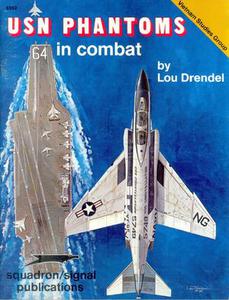
Lou Drendel - USN Phantoms in Combat - Vietnam Studies Group series
Squadron/Signal Publications | 1988 | ISBN: 0897472136 | English | 66 pages | PDF | 37.08 MB
Squadron/Signal Publications 6352
The McDonnell Douglas F-4 Phantom II is in its 30th year of operational service as this book goes to press. That is a remarkable accomplishment for any aircraft and is usually reserved for more staid types, such as the Douglas DC-3. For a front-line fighter to serve that long, where combat is fast, furious, and survivable only by those at the leading edge of technology, is even more astounding. The McDonnell Aircraft engineers designed an aircraft in the late 1950s which surmounted an aerodynamic design plateau which has endured to this day (with only minor modifications). This book is not a 'nuts and bolts' design history of the Phantom, but since the Phantom II was originally designed for the Navy, it seems appropriate to include a brief pictorial design history in 'U.S. Navy Phantoms in Combat".
Ironically, the most prolific fighter of modern times began life as a loser. The fledgling Phantom II came in second to the Vought F8U Crusader in the Navy design competition to acquire its first supersonic fighter. The Crusader was a prototypical fighter; single seat, single engine, armed with guns, and having no fire-control radar. It was a fighter pilot's dream...a pure VFR supersonic dogfighting machine, designed for one-on-one combat in the supersonic age. The losing McDonnell entry had also been a single-seater with a gun. but it came at the dawn of the age of the missileers...the proponents of the missile armed interceptor. Their reasoning went something like this; "Why get in close and grunt under heavy G while you went round and round with the enemy, when it was much easier to blast him out of the sky from long range with a sophisticated air-to-air missile?" As a result, the follow-on McDonnell fighter design diverged radically from accepted fighter aircraft design criteria of the day.



